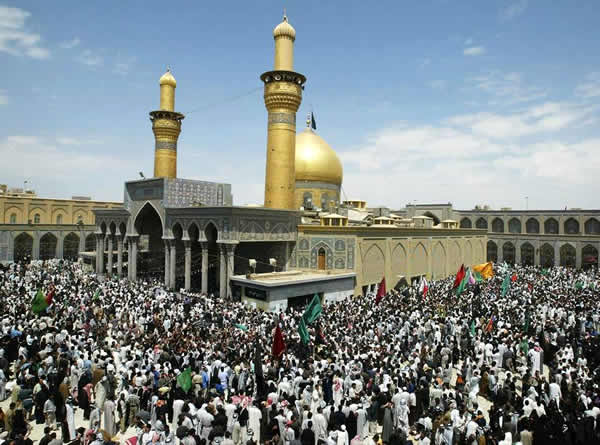 |
| Husayn meet Yazid army |
Shi’ism is the belief that Ali and his descendants are the rightful Muslim leaders. Over the centuries a separate body of Shi’i law and practices has also developed. The Shi’i argued that Ali should have been selected as the first caliph following the prophet Muhammad’s death.
After having been rejected as caliph three times, Ali finally became the caliph only to have his claim immediately questioned by Muaw’iya, the governor of the powerful and wealthy Syrian province, his family the Umayyads, A’isha (the Prophet’s widow), and many other Muslims. Mediation failed to resolve the dispute and for a time there were two claimants to the caliphate.
After Ali’s death in 661, his son Hasan renounced any claim to the caliphate and Muaw’iya became the undisputed leader. However after Muaw’iya’s death in 680, Ali’s younger son Husayn claimed he was the legitimate caliph not Yazid, Muaw’iya’s son.
  |
As Husayn and his supporters were moving to confront Yazid, they were attacked by a far bigger force at Karbala in present-day Iraq. Vastly outnumbered and taken by surprise, Husayn and his men were killed and their heads were severed and presented to Yazid. However several of Husayn’s children managed to survive and carried on the family claim to leadership.
Husayn and his followers became martyrs in Shi’i tradition and their deaths are mourned and commemorated with displays of self-flagellation and passion plays on the day of Ashura during the month of Muharram. Husayn’s tomb in Karbala became a major Shi’i site of pilgrimage and his memory elicted profound sadness over the believers’ failure to save him.
However subsequent disputes over the rightful imam or heir to Husayn and his family led to the creation of a number of different sects among Shi’i followers.
Twelver Shi’i accepted the line of rule from Ali to Muhammad al-Muntazar al-Mahdi. He died in 878 but Shi’i believed he merely disappeared into “occulation” where he observed life but was invisible to humans. Twelvers believed that he would return as the Mahdi, or “rightly guided one,” to announce the Day of Judgment.
He continued to communicate through ayatollahs, who became the intercessors between the imam and the believers. In the contemporary era, Iran remained a Twelver Shi’i nation and large numbers of Twelvers lived in Iraq, Lebanon, and Bahrain.
Zaydi Shi’is were also known as Fivers, who split off in the eighth century. They supported Zayd, the grandson of Husayn, as the rightful imam. In the late ninth century, the Zaydis founded a kingdom in Yemen where they ruled from safe-holds in remote mountainous regions. In 1891 Imam Muhammad ibn Yahya Hamid ad Din established a hereditary Zaydi dynasty that lasted until the 1962 revolution in Yemen.
The Isma’ilis, established in 765, were another offshoot of Shi’ism. They established the Fatimid dynasty in Egypt and survived in India and scattered elsewhere around the world. In the contemporary age, they were led by the Aga Khan, a hereditary position.
The Alawites broke off from the Twelvers in the ninth century, following the eleventh imam, Hasan al Askari (d. 873), and his student Ibn Nusayr (d. 868). They were sometimes, rather prejoratively, referred to as Nusayris.
 |
| Karbala nowdays |
The Alawites venerated Ali as an incarnation of God and also assimilated a number of Christian influences. Alawites ruled Aleppo in northern Syria for a short period but were attacked by both the Isma’ilis and ethnic Kurds and were persecuted as a religious minority by the Mamluks and Ottomans.
Alawite practices seemed to deviate so far from orthodox Sunni practice that some Muslims claimed they were not true believers. Under the Ottomans they were disaffected socially and economically.
The coastal area of northern Syria around Latakia remained an Alawite region and in the second half of the 20th century they used positions in key army posts to become the long-term rulers of Syria.
   |
The Druze were another Shi’i splinter group, who broke off under the Fatimid caliph al-Hakim in the 11th century. Some of al-Hakim’s supporters, including Muhammad al-Darazi, taught that he was the incarnation of God.
Al-Darazi was assassinated in 1019 and his followers became known as the Druze. Al-Hakim disappeared in 1021 and the Druze took refuge in the remote mountains of Lebanon. They developed an elaborate secret ritual and belief system known only to adult male members of the sect.
The secrecy surrounding Druze beliefs gave rise to numerous speculations about their practices. Although the Druze are historically an offshoot of Islam, their belief system seemed so far from general Muslim practice that they were generally considered to practice a separate religion.
Tight knit Druze communities and their reputation for military prowess, coupled with the fragile confessional nature of the modern Lebanese state, enabled the Druze to exercise political power in excess of their actual population in the contemporary era. Small Druze populations are also found in modern-day Syria and Israel.
The Shi’i often composed the lower social and economic strata in Muslim states. Throughout most of Muslim history, the rulers have generally been orthodox Sunnis, even in areas such as Iraq or Bahrain where the Shi’i made up a large part or even the majority of the population. After the 1979 revolution in Iran there was a resurgence of Shi’i activism that spread throughout much of the Muslim world.